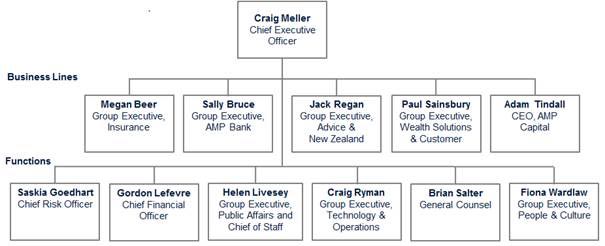In addition, AMP announced two significant actions as part of its update to address the marketconditions for wealth protection in Australia:
- the implementation of a significant reinsurance arrangement with Munich ReinsuranceCompany of Australasia Limited (Munich Re), and
- strengthening of best estimate assumptions across both AMP Life and NMLA effective31 December 2016.
AMP Chief Executive Craig Meller said: “We’ve seen consistent deterioration in the insurance sector over the course of 2016 and, despite the progress on claims transformation to date, it has significantly impacted the performance of our wealth protection business.
“Today’s actions are designed to re-set the wealth protection business. They will improve the group’s earnings stability, free-up capital and help bring into focus the growth potential of AMP.
“While cashflows remained subdued during the third quarter, they were impacted by the ongoing uncertainty in superannuation legislation leading to lower consumer confidence in the system,advisers adjusting to the enhanced regulatory environment and recent investment market volatility
“However AMP is optimistic that the recent superannuation reforms will reverse this trend.”
Business update for the Australian wealth protection business
The series of actions AMP announced today will, subject to regulatory approval, release capitalfrom the wealth protection business and provide greater earnings stability across the group.In more detail they are:
Significant reinsurance deal
AMP’s focus is to reposition the wealth protection business in Australia as significantly less capitalintensive with market-leading products and a transformed claims philosophy and process.
AMP Life has executed a binding quota share agreement with Munich Re to reinsure 50 per cent of $750 million of annual premium income of the AMP Life retail portfolio (including income protection and lump sum business). The agreement will commence on 1 November 2016.
The agreement creates the potential to release up to $500 million of capital from AMP Life subject to regulatory approval. This initial tranche of reinsurance will reduce the magnitude of earnings volatility from the Australian wealth protection business for the AMP group.
The estimated net impact from the agreement on the Australian wealth protection business profit margins is a $25 million reduction annually from FY 17.
AMP intends to pursue further tranches of reinsurance when time and conditions suit.
Strengthening of best estimate assumptions and goodwill impairment
The challenges AMP has faced in its Australian wealth protection business over the last three years have been accentuated in 2016 by deteriorating experience across the life insurance sector.
This has been driven by a range of factors in a period of unprecedented external scrutiny.
This trend has continued into Q3 2016 resulting in an experience loss of $44 million.
Having reviewed experience against long-term trends, AMP has come to the view that the current trends are structural in nature. In response, AMP expects to strengthen best estimate assumptions across both AMP Life and NMLA (including retail and group income protection, claims and lapses)from year end.
As a result, the following underlying profit impacts are anticipated:
- capitalised losses and other one off experience items in the order of $500 million in FY 16,and
- reduction in Australian wealth protection profit margins for FY 17 in the order of $65 million.
The anticipated assumption changes will reduce the Australian wealth protection embedded value at FY 16 by approximately $1.0 billion at a 5 per cent discount margin. The reinsurance agreement results in a negligible change in embedded value (prior to any capital release from AMP Life).
Goodwill attributable to the Australian wealth protection business is expected to be fully impairedby $668 million when preparing the 2016 year-end financial statements. This reflects a decline inthe potential recoverable amount for the Australian wealth protection business in line withreductions in embedded value.
The impairment charges will not impact AMP’s FY 16 underlying profit.
Note that all items above are approximate, unaudited and subject to change as full year reporting processes are completed. The Part 9 consolidation of NMLA with AMP Life is on track and will notbe impacted by the assumption changes or goodwill impairment.
Wealth protection experience for Q3 2016
Experience losses for Q3 16 were $44 million compared with experience losses of $42 million in1H 16, reflecting:
- retail income protection experience losses of $18 million
- retail lump sum experience losses of $8 million
- group insurance claims experience losses of $12 million, and
- lapse experience losses of $6 million.
Q3 16 experience reflected ongoing challenges in the market environment, seasonality of lapsesand lower than expected Group Salary Continuance and income protection terminations.
2H 16 wealth protection experience guidance/
AMP’s Australian wealth protection business continues to operate in a difficult market environment.As a result, if year to date trends continue into Q4 16, in addition to the impacts of potential bestestimate assumption changes, experience losses for the Australian wealth protection business in2H 16 are likely to be in the order of $75 million. However, experience by its nature will be volatile from period to period.
FY 17 wealth protection guidance
FY 17 profit margins for the Australian wealth protection business are expected to be impacted bya combination of strengthened assumptions ($65 million) and execution of the reinsuranceagreement ($25 million). As a result, profit margins in FY 17 are expected to reduce byapproximately $90 million.
Q3 16 Cashflows and AUM update
Australian wealth management net cash outflows were $327 million for the quarter, down from net cashflows of $241 million in Q3 15, driven by the uncertainty in superannuation legislation,advisers adjusting to an enhanced regulatory environment and recent investment market volatility driving weaker inflows in retail products. AMP is optimistic that recent government announcements will reverse the trend in superannuation contributions.
Internal inflows were $4.4 billion in Q3 16 ($4.3 billion in Q3 15) representing 61 per cent(57 per cent in Q3 15) of total cash inflows.
Total AUM was $118.1 billion, up 3 per cent from $115.0 billion at the end of Q2 16 (up 6 per centfrom $111.1 billion at Q3 15). The increase since June 30 reflected positive investment market movements during the quarter. Average AUM increased by 3 per cent to $117.8 billion from Q3 15
AMP’s leading wrap platform North reported net cashflows of $1.1 billion in Q3 16, up 2 per centfrom Q3 15. 49 per cent of North’s net cashflows were externally sourced. North AUM grew to$25.2 billion at the end of the quarter, up 8 per cent from $23.4 billion at the end of Q2 16 and increased by 32 per cent from $19.1 billion at Q3 15.
AMP Flexible Super reported net cash outflows of $83 million in Q3 16, down from net cashflows of$274 million in Q3 15, driven by increasing preference for North by new and existing pension customers and the weaker industry environment. Flexible Super AUM increased by 2 per cent inQ3 16 to $15.7 billion and increased 8 per cent from $14.4 billion at Q3 15.
Corporate superannuation reported net cash outflows of $69 million in Q3 16 down $96 million from Q3 15. The prior period benefited from member transitions from a large mandate win which did not repeat in Q3 16.
External platform net cash outflows were $454 million in Q3 16 compared to net cash outflows of$493 million in Q3 15. This improvement in net outflows was largely the result of lower net cashout flows from advisers who left Genesys offset by lower platform inflows as advisers continue touse North as the preferred platform.
SuperConcepts now supports 54,910 administration and software funds representing 9.5 per centof the market. Growth of 40 per cent in the quarter was driven by the acquisition of additional SMSF software clients as part of the strategic partnership with accounting software provider Reckon, announced in August. Administration funds in the quarter fell 336 to 16,440.Total reported assets under administration grew by $3.9 billion in the quarter to $22.2 billion primarily from a strategic collaboration with a big four accountancy firm.
AMP Capital net cash outflows for Q3 16 were $208 million, comprising external cash inflows of$498 million for the quarter and internal net cash outflows of $706 million.
External flows benefited from strong flows into the China Life AMP Asset Management Company(CLAMP) offset by redemptions from the China Growth Fund and the loss of a $500 million lowmargin passive equities mandate. Overall, external net cashflow performance continues to reflecta shift from lower to higher margin asset classes.
AMP’s share of the CLAMP alliance delivered strong flows of $786 million in the third quarter.This partially reflects timing impacts around money market fund flows, as well as new fundlaunches during the quarter.
AMP Capital AUM at the end of Q3 16 was $162.5 billion, up 1 per cent from $160.4 billion at theend of Q2 16 (and $157.5 billion at Q3 15). Average AUM increased 2 per cent over the quarter to$163.2 billion.
AMP Bank’s loan book increased 3 per cent to $16.6 billion at the end of Q3 16 from $16.0 billion at Q2 16. The deposit book increased $1,116 million (10 per cent) in Q3 16 relative to Q2 16.
AMP New Zealand financial services’ net cashflows of $122 million were $63 million lower than in Q3 15 reflecting lower KiwiSaver flows and a reduction in one off transfers of clients onto NZ financial services platforms. New superannuation cashflow mandates are expected in Q4 16following other providers opting not to enter the updated regulatory regime required by the Financial Markets Conduct Act.
Australian mature
Australian wealth protection annual premium in-force (API) increased 3 per cent in Q3 16 to$1,984 million compared to $1,927 million in Q2 16. The increase in API was primarily driven by a4.6 per cent increase in individual lump sum.
Dividend and capital update
The AMP Limited board will decide on the final 2016 dividend in February 2017, based on the conditions at that time.
Due to the one off and largely non-cash nature of the changes announced today, the Board intends to exclude these impacts on current profits when determining the final 2016 dividend. It will also consider AMP’s enhanced capital strength and future earnings sustainability.
AMP’s policy remains to pay dividends on a payout ratio of 70-90 per cent of underlying profits.
The impact of anticipated best estimate assumption changes will absorb approximately$270 million of regulatory capital. This will be covered from within existing capital surplus and thecapital release expected from the Part 9 life company consolidation which will be in the order of$100 million.
AMP maintains a strong balance sheet and is well capitalised. The proceeds from the reinsurance agreement are anticipated to increase the existing surplus to AMP’s minimum regulatory requirements, which at 30 June 2016 was $1.9 billion. Consequently AMP will consider a range of capital management alternatives including a return of surplus capital to shareholders.








